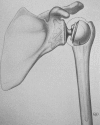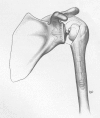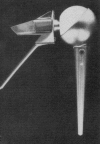A history of reverse total shoulder arthroplasty
- PMID: 21213090
- PMCID: PMC3148354
- DOI: 10.1007/s11999-010-1733-6
A history of reverse total shoulder arthroplasty
Abstract
Background: Management of the cuff-deficient arthritic shoulder has long been challenging. Early unconstrained shoulder arthroplasty systems were associated with high complication and implant failure rates. The evolution toward the modern reverse shoulder arthroplasty includes many variables of constrained shoulder arthroplasty designs.
Questions/purposes: This review explores the development of reverse shoulder arthroplasty, specifically describing (1) the evolution of reverse shoulder arthroplasty designs, (2) the biomechanical variations in the evolution of this arthroplasty, and (3) the current issues relevant to reverse shoulder arthroplasty today.
Methods: Using a PubMed search, the literature was explored for articles addressing reverse shoulder arthroplasty, focusing on those papers with historical context.
Results: Results of the early designs were apparently poor, although they were not subjected to rigorous clinical research and usually reported only in secondary literature. We identified a trend of glenoid component failure in the early reverse designs. This trend was recognized and reported by authors as the reverse shoulder evolved. Authors reported greater pain relief and better function in reverse shoulder arthroplasty with the fundamental change of Grammont's design (moving the center of rotation medially and distally). However, current reports suggest lingering concerns and challenges with today's designs.
Conclusions: The history of reverse shoulder arthroplasty involves the designs of many forward-thinking surgeons. Many of these highly constrained systems failed, although more recent designs have demonstrated improved longevity and implant performance. Reverse shoulder arthroplasty requires ongoing study, with challenges and controversies remaining around present-day designs.
Figures








References
-
- Blauth W, Donner K. Notes on the history of arthroplasty (author’s transl) [in German] Z Orthop Ihre Grenzgeb. 1979;117:997–1006. - PubMed
Publication types
MeSH terms
LinkOut - more resources
Full Text Sources
Other Literature Sources
Medical

